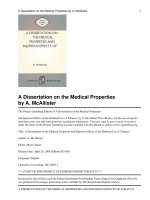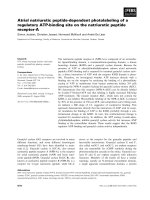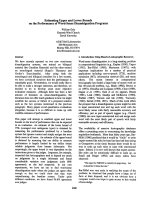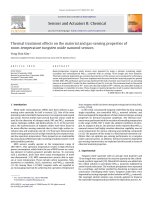LOWER BOUNDS ON THE KOBAYASHI METRIC NEAR A POINT OF INFINITE TYPE
Bạn đang xem bản rút gọn của tài liệu. Xem và tải ngay bản đầy đủ của tài liệu tại đây (209.65 KB, 15 trang )
LOWER BOUNDS ON THE KOBAYASHI METRIC NEAR A POINT
OF INFINITE TYPE
TRAN VU KHANH
Abstract. Under a potential-theoretical hypothesis named f -Property with f satisfy∞
da
ing
< ∞, we show that the Kobayashi metric K(z, X) on a weakly pseudoaf
(a)
t
convex domain Ω, satisfies the estimate K(z, X) ≥ Cg(δΩ (x)−1 )|X| for any X ∈ T 1,0 Ω
where (g(t))−1 denotes the above integral and δΩ (z) is the distance from z to bΩ.
AMS Mathematics Subject Classification (2000): Primary 32F45, 32H35
Key words and phrases: Kobayashi metric, proper holomorphic map, finite and infinite
type
Contents
1. Introduction
2. The bumping function
3. Proof of Theorem 1.2
4. Application to proper holomorphic maps
Acknowledgement
References
1
4
11
13
14
14
1. Introduction
Let Ω be a pseudoconvex domain in Cn and zo be a boundary point. For a smooth
1
monontonic increasing function f : [1 + ∞) → [1, +∞) with f (t) ≤ t 2 , we say that Ω has
the f -Property at zo if there exist a neigborhood U of zo and a family of functions {φδ }
such that
(i) φδ are plurisubharmonic and C 2 on U and −1 ≤ φδ ≤ 0;
¯ δ > f (δ −1 )2 Id and |Dφδ |
(ii) ∂ ∂φ
δ −1 for any z ∈ U ∩ {z ∈ Ω : −δ < r(z) < 0},
∼
where r is a defining function of Ω.
Here and in what follows, and > denote inequality up to a positive constant. Morever,
∼
we will use ≈ for the combination of
and >.
∼
1
2
T.V. KHANH
In the joint work with G. Zampieri [KZ10], we show that the f -Property implies an
¯
f -estimate for the ∂-Neumann
problem. In another paper [KZ12], we prove that an f f
estimate with
→ ∞ at ∞ implies that the Bergman metric has a lower bound with
log
f 1−η
the rate g(t) =
(t ) for η > 0. The ideas leading to these results follow by Kohn
log
[Koh02], Catlin [Cat83, Cat87] and McNeal [McN92b]. Combining the two results above,
we obtain
Theorem 1.1. Let Ω be a pseudoconvex domain in Cn with C ∞ -smooth boundary and zo
f
∞ for
a point in the boundary bΩ. Assume that the f -Property holds at zo with
log
t → ∞. Then for any η > 0 there is a neigborhood Uη of zo and a constant Cη such that
the Bergman metric B of Ω satisfies
f −1+η
B(z, X) ≥ Cη
(δ
(z))|X|
(1.1)
log Ω
for any z ∈ Uη ∩ Ω and X ∈ Tz1,0 Cn .
The purpose of this paper is to prove a result similar to Theorem 1.1 for the Kobayashi
metric. Let us recall the definition of the Kobayashi metric.
Let Ω be a pseudoconvex domain in Cn ; the function K : T 1,0 Ω → R on the holomorphic
tangent bundle, given by
K(z, X) = inf{α > 0|∃g : ∆ → Ω holomorphic with g(0) = z, g (0) = α−1 X}
= inf{r−1 |∃g : ∆r → Ω holomorphic with g(0) = z, g (0) = X},
(1.2)
is called the Kobayashi metric of Ω. Here ∆ denotes the unit disc and ∆r the disc in C
centered at 0 with radius r.
Our main result is the following
Theorem 1.2. Let Ω be a pseudoconvex domain in Cn with C 2 -smooth boundary bΩ
and zo be a boundary point. Assume that Ω has the f -Property at zo with f satisfying
∞
da
< ∞ for some t > 1, and denote by (g(t))−1 the above, finite, integral. Then,
af (a)
t
there is a neighborhood V of zo such that
K(z, X) > g(δΩ−1 (z))|X|
∼
(1.3)
for any z ∈ V ∩ Ω and X ∈ Tz1,0 Cn .
We remark that Theorem 1.2 may apply to domains of both finite and infinite type; in
the first case we take f (t) = t , g(t) = t , and in the second f (t) = log1+ , g(t) = log t.
KOBAYASHI METRIC NEAR A POINT OF INFINITE TYPE
3
Comparing with Theorem 1.1, we reduce the C ∞ -smoothness of the boundary and
∞
da
slightly strengthen the hypothesis of f in the f -Property since
< ∞ is stronger
af (a)
t
f (a)
= ∞. Morever, we obtain a larger size of the lower bound of the Koythan lim
a→∞ log a
bayashi metric; for example, in the case f = t we have g = t instead of g = t −η and, for
f = log1+ t we have g = log t instead of log (t1−η ).
Using the f -Property constructed by Catlin in [Cat87, Cat89], McNeal [McN91, McN92a],
Khanh-Zampieri [KZ10], Khanh [Kha10], we have the following
Corollary 1.3. 1) Let Ω be a pseudoconvex domain of finite type m in Cn . Then (1.3)
1
holds for g(t) = t m if Ω satisfies at least one of the following conditions: Ω is strongly
pseudoconvex, or Ω is convex, or n = 2, or Ω is decoupled. In any case, we have g(t) = t
2 n2
with = m−n m .
2) Let Ω be defined by Ω = {z ∈ Cn : Imzn +
n−1
j=1
Pj (zj ) < 0}, where ∆Pj (zj ) >
1
exp(−1/|yj |α )
exp(−1/|xj |α )
or
wih α < 1. Then (1.3) holds for g(t) = log α −1 t.
2
2
xj
yj
∼
The lower bound of the Kobayashi metric is an important tool in the function theory
of several complex variables and has been studied by many authors. In the following, we
briefly review some significant, classical results.
When Ω is strongly pseudoconvex or else it is pseudoconvex of finite type in C2 and
decoupled or convex in Cn , then the size of the Kobayashi metric has been described by
I. Graham [Gra75], D. Catlin [Cat89], G. Herbort [Her92] and L. Lee [Lee08]. In these
classes of domains, there exists a quantity M (z, X) which satisfies the asymptotic formula
−1/m
lim M (z, X) = δΩ
z→bΩ
(z)|X τ | + δΩ−1 (z)|X ν |,
(where, X τ and X ν are the tangential and normal components of X and m is the type of
the boundary), such that
K(z, X) ≈ M (z, X).
For a general pseudoconvex domain in Cn , K. Diederich and J. E. Fornaess [DF79]
proved, by using Kohn’s algorithm [Koh79], that there is a > 0 such that K(z, X) >
∼
δ(z)− |X| if bΩ is real analytic of finite type. By using the method of Catlin in [Cat87,
Cat89], S. Cho [Cho92] improved the result of [DF79] for domains which are not necessarily real analytic. However, in the case of infinite type we know very little except from
the recent results by S. Lee [Lee01] for the exponentially-flat infinite type.
4
T.V. KHANH
Among other uses of the lower bound of the Kobayashi metric, we mention the continuous extendibility of proper holomorphic maps to the boundary of a domain of general
type. We refer readers to [Hen73, BF78, DF79, Ran78] for this problem on domains of
finite type.
Theorem 1.4. Let Ω and Ω be pseudoconvex domains. Let η, 0 < η ≤ 1 be such that there
is a C 2 defining function r of Ω with the property that −(−r)η is strictly plurisubharmonic
∞
(ln a − ln t)da
< ∞ for
on Ω. Assume that Ω has the f -Property with f satisfying
af (a)
t
some t > 1, and denote by (f˜(t))−1 this finite integral. Then any proper holomorphic map
ˆ :Ω
¯ →Ω
¯ with a rate
Ψ : Ω → Ω can be extended as a general H¨older continuous map Ψ
f˜(tη ), that is,
ˆ
ˆ
|Ψ(z)
− Ψ(w)|
f˜(|z − w|−η )−1
¯
for any z, w ∈ Ω.
The paper is organized as follows. In section 2, using the f -Property, we construct
the bumping functions. By the existence of suitable exhaustion functions, we obtain the
plurisubharmonic peak functions having the good estimates. The lower bound of the
Kobayashi metric follows from the estimates of the plurisubharmonic peak functions (cf.
Section 3). In Section 4, we prove Theorem 1.4.
2. The bumping function
In this section, we construct the bumping functions, which might also be useful for
other purposes. We will prove that, for any boundary point zo on bΩ which satisfies the
¯ exactly at w from the
f -Property, we can find a pseudoconvex hypersurface touching Ω
outside such that the distance from z ∈ Ω to the new hypersurface is exactly controlled
by the rate in|z − w|−1 of the reciprocal of the inverse of g.
Theorem 2.1. Let Ω be pseudoconvex and zo be a boundary point. Assume that Ω has
∞
da
the f -Property at zo with f satisfying
< ∞ for some t > 1, and denote by
af (a)
t
(g(t))−1 this finite integral. Then there is a neigborhood U of zo and a real C 2 function ρ
on U × (U ∩ bΩ) with the following properties:
(1) ρ(w, w) = 0.
(2) ρ(z, w) ≤ −G(|z − w|) for any (z, w) ∈ (U ∩ Ω) × (U ∩ bΩ) where G(δ) =
−1
(g ∗ (γδ −1 ) . Here, the supercript ∗ denotes the inverse function and γ > 0 sufficiently small.
(3) ρ(z, π(z))
−δΩ (z) for any z ∈ U ∩ Ω where π(z) is the projection of z to the
boundary.
(4) For each fixed w ∈ U ∩ bΩ, denote Sw = {z ∈ U : ρ(z, w) = 0}. One has:
KOBAYASHI METRIC NEAR A POINT OF INFINITE TYPE
5
(a) |Dz ρ(z, w)| ≈ 1 everywhere on Sw .
(b) Sw is pseudoconvex. In fact, one can choose ρ such that Sw is strongly pseudoconvex outside of w.
¯ exactly at w from outside.
(c) Sw touches Ω
The proof is divided in four steps. In step 1, we show the equivalence of the f -Property
between the pseudoconvex and the pseudoconcave side of a hypersurface. In step 2, we
prove that there exists a single function with self-bounded gradient which has a lower
bound f (r−1 (z)) for the Levi form. In step 3, we estimate the function G. The properties
of bumping function is checked on step 4.
Proof of Theorem 2.1.
Step 1. Since the hypersurface defined by each bumping function lies outside the original domain except from one point and the f -Property takes place inside the domain, we
first show hat the f -Property still holds outside the domain.
Without loss of generality, we can assume that the original point zo belongs to U ∩ bΩ.
We choose special coordinates z = (x, r) ∈ R2n−1 × R at zo . Assume that there is a family
of functions φδ which have properties (i) and (ii) in the first paragraph of Section 1. Define
φ˜δ (x, r) := φδ (x, r − δ) for each δ > 0 and still call φδ for φ˜δ . Then, for each δ, φδ is C 2 ,
¯ δ > f 2 (δ −1 )Id, and |Dφδ | δ −1
plurisubharmonic, and satisfies on U −1 ≤ φδ ≤ 0, ∂ ∂φ
on −δ < r − δ < 0 or 0 < r < δ.
∼
Step 2. In this step we construct a single function which has self-bounded gradient
and has lower bound f (r−1 (z)) for the Levi form.
Lemma 2.2. Assume that Ω enjoys the f -Property at z0 . Then there is a single function
Φ and constants c, C > 0 such that
(1) −1 Φ ≤ 0
1 ¯
¯
¯ + 1 |Xr|2 ) + 1 |XΦ|2 + cf 2 ( 1 )|X|2
X)|
(2) ∂ ∂Φ(X,
X) ≥ −C( |∂ ∂r(X,
r
r2
8
r
1
(3) |DΦ|
r
¯
for any z ∈ U \ Ω.
6
T.V. KHANH
Proof. Let χ be a cut-off function such that χ(t) =
0
1
if t ≤ or t ≥ 2.
4
We also
1
if ≤ t ≤ 1.
2
1
suppose that |χ|,
˙ |χ|
¨ and
χ˙ 2
are bounded. Define
χ
∞
(exp(φ2−j (z)) − 1) χ(2j r(z)).
Φ(z) :=
(2.1)
j=1
∞
¯ = ∪ S2−k \ S2−(k+1) , then there is an
Denote Sδ := {z ∈ U |0 < r(z) < δ}. Let z ∈ U \ Ω
j=1
integer k such that
z ∈ S2−k \ S2−(k+1) = {z ∈ U : 2−k−1 ≤ r(z) < 2−k }.
(2.2)
We notice that χ(2j r(z)) = 0 if j < k − 1 or j > k + 1, and χ(2k r(z)) = 1 for any
z ∈ S2−k \ S2−(k+1) . Hence, (2.1) can be rewritten that
k+1
(exp(φ2−j (z)) − 1) χ(2j r(z)).
Φ(z) =
j=k−1
This proves (1). We observe that
∂ ∂¯
¯ 2−j (X, X)
¯ = ∂ ∂φ
¯ + |Xφ2−j |2 eφ2−j χ
eφ2−j − 1 χ(2j r) (X, X)
+ 2j+1 Re Xφ2−j , Xr eφ2−j χ˙
¯
¯ χ˙ + 22j |Xr|2 χ¨ (eφ2−j − 1)
+ 2j ∂ ∂r(X,
X)
¯ 2−j (X, X)
¯ + 1 |Xφ2−j |2 eφ2−j χ
≥ ∂ ∂φ
2
j
φ2−j
¯
¯
− 2 χ(1
˙ −e
)|∂ ∂r(X,
X)|
− 22j (|χ|(1
¨ − eφ2−j ) + 2
χ˙ 2 φ −j
e 2 )|Xr|2 .
χ
Here, we use the Cauchy-Schwartz inequality for the second line of (2.3), that is,
1
χ˙ 2
2j+1 Re Xφ2−j Xr eφ2−j χ˙ ≤ |Xφ2−j |2 eφ2−j χ + 22j+1 |Xr|2 .
2
χ
(2.3)
KOBAYASHI METRIC NEAR A POINT OF INFINITE TYPE
7
Moreover, we also observe that
k+1
2
X(φ2−j )eφ2−j χ + 2j (eφ2−j − 1)X(r)χ(2
˙ j r)|2
|XΦ(z)| =|
j=k−1
(2.4)
k+1
|Xφ2−j |2 eφ2−j χ(2j r) + 22k+2 (1 − e−1 )2 |Xr|2
≤4
j=k−1
1 2 k−1
χ˙ (2 r) + 4χ˙ 2 (2k+1 r)
4
Combining (2.3) and (2.4), we obtain
¯
¯ 2−k (X, X)
¯
¯ ≥e−1 ∂ ∂φ
¯ + 1 |XΦ|2 − C(2k |∂ ∂r(X,
¯ + 22k |Xr|2 )
∂ ∂Φ(X,
X)
X)|
8
1
¯
¯ + 22k |Xr|2 )
≥cf 2 (2k )|X|2 + |XΦ|2 − C(2k |∂ ∂r(X,
X)|
8
(2.5)
for any z ∈ S2−k \ S2−(k+1) . From (2.4), we also obtain |DΦ| 2k z ∈ S2−k \ S2−(k+1) since
|Dφδ | δ −1 and |Dr| 1. This completes the proof of (2) and (3).
−1
∞
−1
−1
t
da
da
for any t > 1.
=
Step 3. We recall that g(t) =
af (a)
af (a−1 )
t
0
Then, it is easy to check that g is increasing, g → ∞ at ∞, and g ≤ f on (1, +∞). We
define
−1
G(δ) := g ∗ ((γδ)−1
where γ > 0 is a constant to be chosen later. We also notice that G is an increasing
function, and G(0) = 0.
Claim: For δ > 0, we have
˙
G(δ)
(1)
= γf (G−1 (δ));
G(δ)
¨
(2) G(δ)G(δ)
≤ G˙ 2 (δ);
G(δ)
˙
(3)
≤ G(δ).
δ
Proof of the Claim. By the definition of G and g, we have
G(δ)
−1
−1
g(G(δ) ) = (γδ)
or
0
da
= γδ.
af (a−1 )
(2.6)
Taking the derivative with respect to δ in the second equation of (2.6), we prove the first
claim, that is,
˙
G(δ)
= γf (G−1 (δ)).
G(δ)
(2.7)
8
T.V. KHANH
Taking again the derivative with respect to δ in (2.7), and observing that
−
˙ f˙(G−1 (δ))
¨
γ G(δ)
G(δ)G(δ)
− G˙ 2 (δ)
=
,
G2 (δ)
G2 (δ)
(2.8)
(since G and f are increasing functions) we get the proof of the second claim. Moreover, since f ≥ g, then G−1 (δ) = g ∗ ((γδ)−1 ) ≥ f ∗ ((γδ −1 )). From (2.7) we then get
˙
G(δ)
≥ γf (f ∗ ((γδ)−1 )) = δ −1 . The proof of the Claim is complete.
G(δ)
Step 4. We define
ρ(z, w) = r(z) + G(|z − w|) (−1 + Φ(z))
where > 0 will be chosen later.
Let Sw = {z ∈ U |ρ(z, w) = 0} be a hypersurface defined by ρ(z, w) = 0 where w is
fixed. We will prove that ρ satisfies the following properties:
(i)
(ii)
(iii)
(iv)
(v)
ρ(w, w) = 0 for any w ∈ bΩ.
ρ(z, w) ≤ −G(|z − w|) for z ∈ U ∩ Ω and w ∈ U ∩ bΩ.
ρ(z, π(z)) −r(z) for z ∈ U ∩Ω, where π(z) is the projection of z to the boundary.
Sw is pseudoconvex.
|Dz ρ(z, w)| ≈ 1 on Sw .
Now, (i) is obvious. Since Φ is negative and bounded, we first choose so small that
−2 ≤ −1 + Φ ≤ −1. For z ∈ U ∩ Ω, we have r(z) < 0, and |r(z)| ≥ G(|r(z)|), hence (ii)
and (iii) follow.
KOBAYASHI METRIC NEAR A POINT OF INFINITE TYPE
9
We estimate the Levi form of ρ with respect to z,
˙
G(|z
− w|)
¯
¨ − w|) (−1 + Φ(z))|X|2
∂z ∂¯z ρ(z, w)(X, X) =∂ ∂r(X,
+ G(|z
X) +
|z − w|
¯
+ 2 Re XG(|z − w|), XΦ(z) + G(|z − w|)∂ ∂Φ(z)(X,
X)
˙
˙2
G(|z
− w|)
¯
¨ − w|) + 8 G (|z − w|) |X|2
+ G(|z
≥∂ ∂r(X,
X) − 2
|z − w|
G(|z − w|)
1
¯
+ G(|z − w|) ∂ ∂Φ(z)(X,
X) − |XΦ(z)|2
(2.9)
16
1 ¯
¯
¯ + 1 |Xr|2
|∂ ∂r(X, X)|
≥∂ ∂r(X,
X) − CG(|z − w|)
r
r2
1
+ cG(|z − w|)f 2 ( )|X|2 + G(|z − w|)|XΦ|2
r
16
˙2
˙
G(|z − w|)
¨ − w|) + 8 G (|z − w|) |X|2
+ G(|z
−2
|z − w|
G(|z − w|)
Here, the first inequality follows from Cauchy-Schwartz inequality as for the second line;
the last inequality follows from Lemma 2.2(ii).
¯ that is, r(z) = G(|z − w|) 1 − Φ(z) . By
Now we consider z ∈ (Sw ∩ U ) \ w ⊂ U \ Ω,
the choice of , we obtain
G(|z − w|) ≤ |r(z)| ≤ 2G(|z − w|).
(2.10)
Thus the inequality of (2.9) continues as
¯
¯
∂z ∂¯z ρ(z, w)(X, X) ≥∂ ∂r(z)(X,
X) − 2 C|∂ ∂r(X,
X)| −
+
+
16
4C
|Xr|2
G(|z − w|)
G(|z − w|)|XΦ|2
c G(|z − w|)f 2
1
G(|z − w|
Here the last line follows from Claim (2) and (3).
(2.11)
− (4 + 16 )
G˙ 2 (|z − w|)
G(|z − w|)
|X|2
10
T.V. KHANH
Choose
small such that 2 C ≤ 1; the first line of (2.11) can be estimated as follows
4C
¯
¯
∂ ∂r(z)(X,
X) − 2 C|∂ ∂r(X,
X)| −
|Xr|2
G(|z − w|)
2
¯
¯
≥ ∂ ∂r(z)(X,
X) − |∂ ∂r(X,
X)| −
|Xr|2
G(|z − w|)
(2.12)
2
|Xr|2
≥ C1 |X||Xr| −
G(|z − w|)
2
C
3
≥ − 1 G(|z − w|)|X|2 −
|Xr|2
4
G(|z − w|)
For X ∈ T 1,0 Sw , that is, Xρ = 0. This implies
Xr = (1 − Φ)XG(|z − w|) − G(|z − w|)XΦ,
and hence,
|Xr|2 ≤ 8G˙ 2 (|z − w|)|X|2 + 2 2 G2 (|z − w|)|XΦ|2 .
The inequality (2.12) continues as
G˙ 2 (|z − w|)
|X|2 − 6 2 G(|z − w|)|XΦ|2 .
≥ −C2
G(|z − w|)
(2.13)
Combining (2.11) and (2.13), we obtain
¯
¯ ≥
∂ ∂ρ(X,
X)
16
−6
2
G(|z − w|)|XΦ|2
+ c G(|z − w|) f
2
1
G(|z − w|)
G˙ 2 (|z − w|)
− C3 2
G (|z − w|)
(2.14)
2
|X|
− 6 2 ≥ 0; then the term in left hand side of the first line
16
of (2.13) can be disregarded. Using Claim (1) with γ > 0 small enough, we obtain that
¯
the term in the second line is positive. We conclude that ∂ ∂ρ(X,
X) ≥ 0 on Sw for any
1,0
X ∈ T Sw . The proof of property (iv) is complete.
Again, choose
such that
For any z ∈ (Sw ∩ U ) \ w, we have
˙
|D (G(|z − w|)(−1 + Φ(z)))| ≤2G(|z
− w|) + G(|z − w|)|DΦ(z)|
≤2ηG(|z − w|)f (G−1 (|z − w|)) +
G(|z − w|)
r(z)
(2.15)
≤2η +
where, the second inequality follows from Claim (1) and Lemma 2.2.(3), the third inequality follows from the hypothesis that f (t) ≤ t and (2.10). Since |Dr| ≈ 1, then for and η
small enough, we obtain |Dρ| ≈ 1. That is the proof of property (v).
KOBAYASHI METRIC NEAR A POINT OF INFINITE TYPE
11
The proof of Theorem 2.1 is complete.
3. Proof of Theorem 1.2
The proof of Theorem 1.2 follows immediately from Theorem 3.1 and Theorem 3.3
below. Theorem 3.1 consists in the construction of plurisubharmonic peak functions with
good estimates. This is a consequence of the construction of bumping functions in last
section. More precisely, we obtain the following
Theorem 3.1. Assume that there exists a family of bumping functions on a local path
V of the boundary as in the conclusion of Theorem 2.1. Fix 0 < η < 1; then for any
w ∈ V ∩ bΩ there is a plurisuhharmonic function ψw on V \ {w} verifying
(1) |ψw (z) − ψw (z )| |z − z |η
(2) ψw (z) ≤ −Gη (|z − w|)
(3) ψπ(z) (z) −δΩ (z)η
¯
for any z and z in V ∩ Ω.
Remark 3.2. The construction of the plurisubharmonic peak functions on a pseudoconvex
domain of finite type in C2 and a convex domain of finite type in Cn has been obtained
by J. E. Fornaess and N. Sibony in [FS89].
Proof of Theorem 3.1. Using the argument in Section 3 and 4 of Diederich-Fornaess
[DF79], we obtain that for any η > 0, there exist an open neighborhood V ⊂ U , and a
constant L > 0, such that
ψw (z) = − −ρ(z, w)eL|z−w|
2
η
,
is a plurisubharmonic function on V ∩ {z ∈ U : ρ(z, w) < 0}. By the properties of ρ, we
can check that ψw satisfies (1), (2) and (3). That is the proof of Theorem 3.1.
Now, we prove the lower bound for the Kobayashi metric by using the plurisubharmonic
peak function. We state the theorem in a more general setting
Theorem 3.3. Let Ω be a pseudoconvex domain in Cn , zo be a given boundary point, F1
and F2 are postive functions such that F1 is increasing and convex. Assume that there is a
neighborhood V of zo such that for each w ∈ V ∩ bΩ, there is a plurisubharmonic function
ψw such that
i) ψw (z) ≤ −F1 (|z − w|)
ii) ψπ(z) (z) ≥ −F2 (δΩ (z))
for z ∈ U ∩ Ω.
Then
KΩ (z, X) ≥ (F1∗ (F2 (δΩ (z)))−1 |X|
12
T.V. KHANH
for all z ∈ V ∩ Ω, X ∈ Tz1,0 Cn .
Proof. We fix now a point z ∈ V ∩ Ω, put w = π(z) and assume that g = (g1 , . . . , gn ) :
∆ → Ω is a holomorphic map of the closed unit disc into Ω with g(0) = z.
By applying the mean value inequality to the subharmonic function ψw (g(t)) on ∆ we
get
1
ψw ◦ g(ei2πθ )dθ
ψw (z) = ψw (g(0)) ≤
0
The hypothesis (ii) gives
1
−ψw ◦ g(ei2πθ )dθ
F2 (δ(z))) ≥
(3.1)
0
We now use the hypothesis (i) of ψw ,
1
1
i2πθ
−ψw ◦ f (e
− ψw ◦ g(ei2πθ ) − F1 (|gj (ei2πθ ) − wj |) dθ
)dθ =
0
0
1
F1 |gj (ei2πθ ) − wj | dθ
+
0
1
F1 |gj (ei2πθ ) − wj | dθ.
≥
0
Using the Jensen inequality for the increasing, convex function F1 , we get
1
1
i2πθ
F1 (|gj (0)|) ≤ F1
|gj (e
0
F1 |gj (ei2πθ ) − wj | dθ.
) − wj |dθ ≤
0
Combining the above inequality with (3.1) and (3.2), we obtain
F1 (|gj (0)|) ≤ F2 (δΩ (z)).
An immediate consequence of this is
|gj (0)| ≤ F1∗ (F2 (δΩ (z)).
By the definition of K(z, X), we must have for all X ∈ T 1,0 Cn
K(z, X) ≥ (F1∗ (F2 (δΩ (z)))−1 |X|.
(3.2)
KOBAYASHI METRIC NEAR A POINT OF INFINITE TYPE
13
4. Application to proper holomorphic maps
Let Ω1 and Ω2 be bounded domains in Cn with smooth boundary. Assume that Ω2 is
pseudoconvex of finite type at every boundary point. It is well-known that there is α > 0,
such that every proper holomorphic map Ψ : Ω1 → Ω2 is H¨older continuous of order
¯ 1 . In this section, we prove a similar result
α, in particular, Ψ extends continuosly to Ω
for domains of infinite type. For this purpose we give a suitable estimate for generalized
H¨older regularity.
Let f be an increasing function such that lim f (t) = +∞. For Ω ⊂ Cn , define the
t→+∞
¯
f -H¨older space on Ω by
¯ = {u : u
Λf (Ω)
∞
+ sup f (|h|−1 ) · |u(z + h) − u(z)| < ∞}
z,z+h∈Ω
and set
u
f
= u
∞
+ sup f (|h|−1 ) · |u(z + h) − u(z)|.
z,z+h∈Ω
¯ by taking f (t) = tα
Note that the f -H¨older space include the standard H¨older space Λα (Ω)
−1
−α
(so that f (|h| ) = |h| ) with 0 < α < 1.
Before proving Theorem 1.4, we need a generalization of the Hardy-Littlewood Lemma.
Lemma 4.1. Let Ω be a bounded Lipschitz domain in RN and let δΩ (x) denote the distance
function from x to the boundary of Ω. Let G : R+ → R+ be an increasing function such
d
G(δ)
G(δ)
that
is decreasing and
dδ < ∞ for d > 0 small enough. Let u ∈ C 1 (Ω)
δ
δ
0
satisfy
|∇u(x)|
G(δΩ (x))
for every x ∈ Ω.
δΩ (x)
d
¯ where f (d−1 ) =
Then u ∈ Λf (Ω)
0
G(δ)
dδ
δ
(4.1)
−1
.
The proof of this theorem can be found in [Kha12].
Remark 4.2. If G(t) = tα , Lemma 4.1 is the classical Hardy-Littlewood Lemma for a
domain of finite type.
Proof of Theorem 1.4 Using Theorem 1.2 for Ω , the Schwarz-Pick lemma for the
Kobayashi metric, and the upper bound of the Kobayashi metric, we obtain the following
estimate
g δΩ−1 (Ψ(z)) |Ψ (z)X|
KΩ (Ψ(z), Ψ (z)X) ≤ KΩ (z, X)
δΩ−1 (z)|X|
(4.2)
14
T.V. KHANH
for any z ∈ Ω and X ∈ T 1,0 Cn . Moreover, by the fact that −(−r)η is strictly plurisubharmonic on Ω, one has δΩ (Ψ(z)) δΩη (z) for any z ∈ Ω (Lemma 8 in [DF79]). Therefore,
|Ψ (z)X|
δΩ−1 (z)g −1 (δΩ−η (z))|X|
for any z ∈ Ω and X ∈ T 1,0 Cn . Using Lemma 4.1, Ψ can be extended to a h-H¨older
ˆ :Ω
¯ →Ω
¯ with the rate h(t) defined by
continuous map Ψ
t−1
1 ∞ db
dδ
=
δg(δ −η )
η tη bg(b)
0
∞
∞
1
1 ∞ 1
1
da
db =
=
η tη b
af (a)
η tη af (a)
b
∞
η
1
ln a − ln t
1
=
da = (f˜(tη ))−1 .
η tη
af (a)
η
The proof of Theorem 1.4 is complete.
−1
(h(t))
:=
a
tη
db
b
da
(4.3)
Acknowledgement
This article was written while the author was a visiting member at the Vietnam Institute
for Advanced Study in Mathematics (VIASM). He would like to thank this institution for
its hospitality and support.
References
[BF78]
[Cat83]
[Cat87]
[Cat89]
[Cho92]
[DF79]
[FS89]
[Gra75]
[Hen73]
[Her92]
Eric Bedford and John Erik Fornæss. Biholomorphic maps of weakly pseudoconvex domains.
Duke Math. J., 45(4):711–719, 1978.
¯
David Catlin. Necessary conditions for subellipticity of the ∂-Neumann
problem. Ann. of Math.
(2), 117(1):147–171, 1983.
David Catlin. Subelliptic estimates for the ∂-Neumann problem on pseudoconvex domains.
Ann. of Math. (2), 126(1):131–191, 1987.
David W. Catlin. Estimates of invariant metrics on pseudoconvex domains of dimension two.
Math. Z., 200(3):429–466, 1989.
Sanghyun Cho. A lower bound on the Kobayashi metric near a point of finite type in Cn . J.
Geom. Anal., 2(4):317–325, 1992.
Klas Diederich and John E. Fornæss. Proper holomorphic maps onto pseudoconvex domains
with real-analytic boundary. Ann. of Math. (2), 110(3):575–592, 1979.
John Erik Fornæss and Nessim Sibony. Construction of P.S.H. functions on weakly pseudoconvex domains. Duke Math. J., 58(3):633–655, 1989.
Ian Graham. Boundary behavior of the Carath´eodory and Kobayashi metrics on strongly
pseudoconvex domains in C n with smooth boundary. Trans. Amer. Math. Soc., 207:219–240,
1975.
G. M. Henkin. An analytic polyhedron is not holomorphically equivalent to a strictly pseudoconvex domain. Dokl. Akad. Nauk SSSR, 210:1026–1029, 1973.
Gregor Herbort. Invariant metrics and peak functions on pseudoconvex domains of homogeneous finite diagonal type. Math. Z., 209(2):223–243, 1992.
KOBAYASHI METRIC NEAR A POINT OF INFINITE TYPE
15
¯
Tran Vu Khanh. A general method of weights in the ∂-Neumann
problem. arxiv:1001.5093v1,
2010. Ph.D. thesis.
[Kha12] Tran Vu Khanh. Supnorm and f -h¨older estimates for ∂¯ on convex domains of general type in
C2 . J. Math. Anal. Appl. (in press: 10.1016/j.jmaa.2013.02.045), arXiv:1206.3702, 2012.
¯
[Koh79] J. J. Kohn. Subellipticity of the ∂-Neumann
problem on pseudo-convex domains: sufficient
conditions. Acta Math., 142(1-2):79–122, 1979.
[Koh02] J. J. Kohn. Superlogarithmic estimates on pseudoconvex domains and CR manifolds. Ann. of
Math. (2), 156(1):213–248, 2002.
[KZ10]
Tran Vu Khanh and Giuseppe Zampieri. Regularity of the ∂-Neumann problem at point of
infinite type. J. Funct. Anal., 259(11):2760–2775, 2010.
[KZ12]
Tran Vu Khanh and Giuseppe Zampieri. Necessary geometric and analytic conditions for
¯
general estimates in the ∂-Neumann
problem. Invent. Math., 188(3):729–750, 2012.
[Lee01]
Sunhong Lee. Asymptotic behavior of the Kobayashi metric on certain infinite-type pseudoconvex domains in C2 . J. Math. Anal. Appl., 256(1):190–215, 2001.
[Lee08]
Lina Lee. Asymptotic behavior of the Kobayashi metric on convex domains. Pacific J. Math.,
238(1):105–118, 2008.
[McN91] Jeffery D. McNeal. Local geometry of decoupled pseudoconvex domains. In Complex analysis
(Wuppertal, 1991), Aspects Math., E17, pages 223–230. Vieweg, Braunschweig, 1991.
[McN92a] Jeffery D. McNeal. Convex domains of finite type. J. Funct. Anal., 108(2):361–373, 1992.
[McN92b] Jeffery D. McNeal. Lower bounds on the Bergman metric near a point of finite type. Ann. of
Math. (2), 136(2):339–360, 1992.
[Ran78] R. Michael Range. The Carath´eodory metric and holomorphic maps on a class of weakly
pseudoconvex domains. Pacific J. Math., 78(1):173–189, 1978.
[Kha10]
Tan Tao University, Tan Tao avenue, Tan Duc e-city, Long An province, Vietnam
E-mail address:









